Ford Marketing Strategy and Consumer Behavior: A Strategic Report
VerifiedAdded on 2023/01/19
|11
|3232
|97
Report
AI Summary
This report provides a comprehensive analysis of Ford's marketing activities, focusing on consumer behavior and marketing psychology. It examines Ford's product overview, current marketing focus, marketing strategy, and communication mix. The report delves into consumer behavior concepts, including the buying process and factors influencing consumer decisions. It explores Ford's target market, segmentation (geographic, demographic, psychographic, and behavioral), and positioning strategies. The marketing communication mix, including product, place, price, and promotion, is analyzed. The report concludes with strategic recommendations for the board of directors, emphasizing the importance of understanding consumer behavior for enhancing operations and adapting to a changing market. The analysis is based on the scenario provided in the assignment brief, which tasks the student with preparing a report based on their analysis of Ford's marketing strategies, consumer behavior, and strategic recommendations for improvement.

Marketing
Paraphrase This Document
Need a fresh take? Get an instant paraphrase of this document with our AI Paraphraser
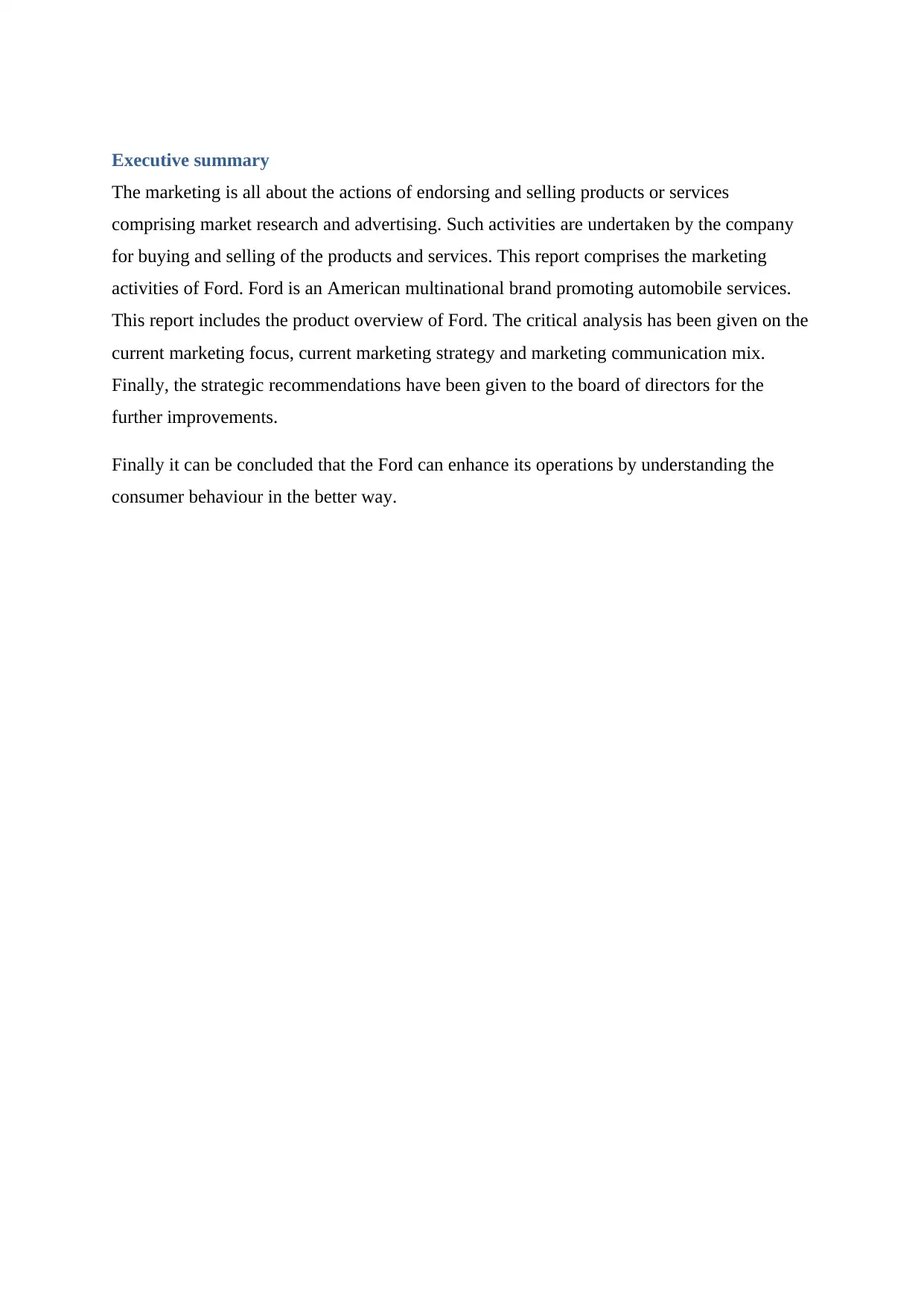
Executive summary
The marketing is all about the actions of endorsing and selling products or services
comprising market research and advertising. Such activities are undertaken by the company
for buying and selling of the products and services. This report comprises the marketing
activities of Ford. Ford is an American multinational brand promoting automobile services.
This report includes the product overview of Ford. The critical analysis has been given on the
current marketing focus, current marketing strategy and marketing communication mix.
Finally, the strategic recommendations have been given to the board of directors for the
further improvements.
Finally it can be concluded that the Ford can enhance its operations by understanding the
consumer behaviour in the better way.
The marketing is all about the actions of endorsing and selling products or services
comprising market research and advertising. Such activities are undertaken by the company
for buying and selling of the products and services. This report comprises the marketing
activities of Ford. Ford is an American multinational brand promoting automobile services.
This report includes the product overview of Ford. The critical analysis has been given on the
current marketing focus, current marketing strategy and marketing communication mix.
Finally, the strategic recommendations have been given to the board of directors for the
further improvements.
Finally it can be concluded that the Ford can enhance its operations by understanding the
consumer behaviour in the better way.

Contents
Executive summary....................................................................................................................1
Product overview.......................................................................................................................3
Critical analysis..........................................................................................................................3
Strategic recommendations........................................................................................................7
References..................................................................................................................................9
Executive summary....................................................................................................................1
Product overview.......................................................................................................................3
Critical analysis..........................................................................................................................3
Strategic recommendations........................................................................................................7
References..................................................................................................................................9
⊘ This is a preview!⊘
Do you want full access?
Subscribe today to unlock all pages.

Trusted by 1+ million students worldwide
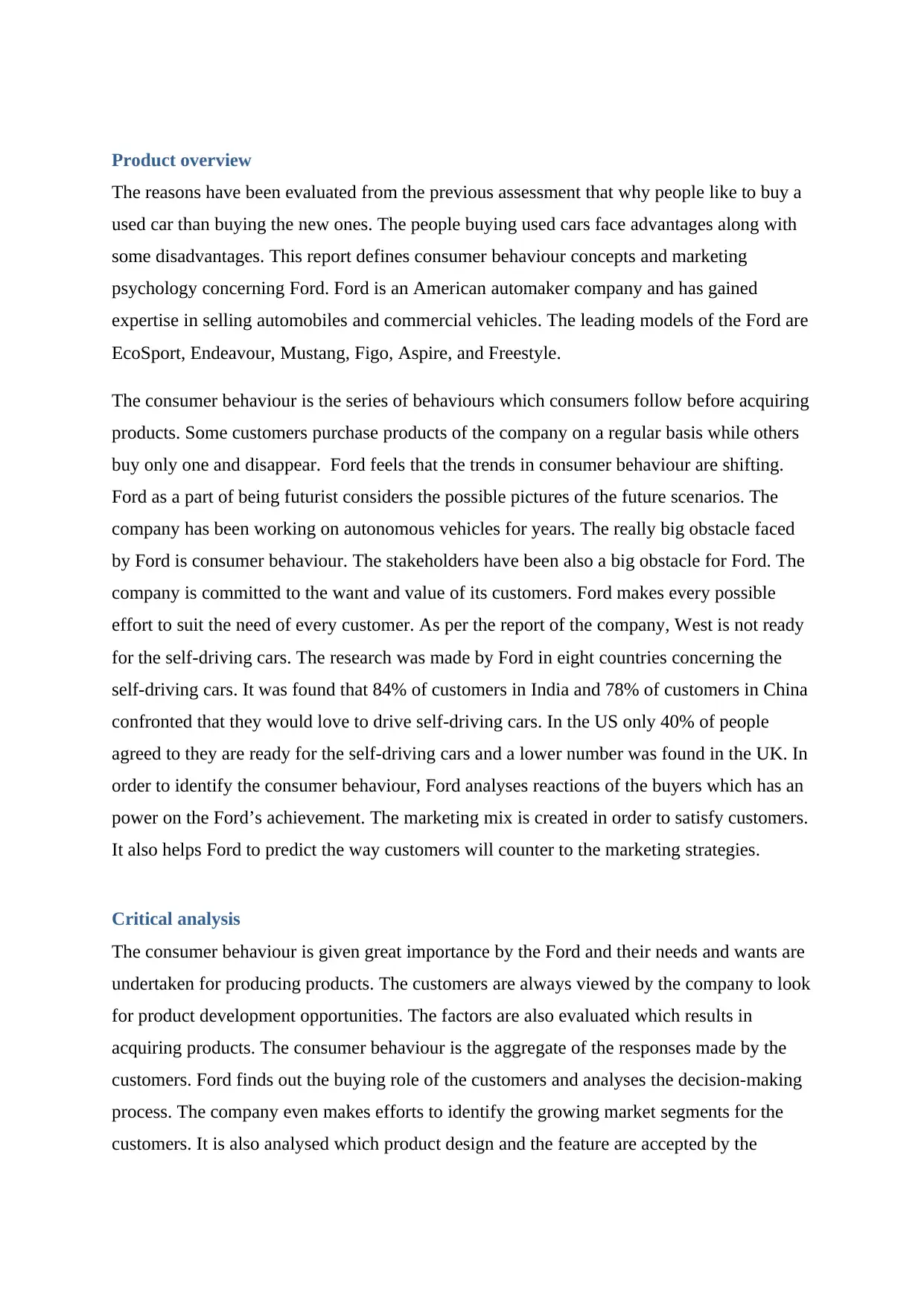
Product overview
The reasons have been evaluated from the previous assessment that why people like to buy a
used car than buying the new ones. The people buying used cars face advantages along with
some disadvantages. This report defines consumer behaviour concepts and marketing
psychology concerning Ford. Ford is an American automaker company and has gained
expertise in selling automobiles and commercial vehicles. The leading models of the Ford are
EcoSport, Endeavour, Mustang, Figo, Aspire, and Freestyle.
The consumer behaviour is the series of behaviours which consumers follow before acquiring
products. Some customers purchase products of the company on a regular basis while others
buy only one and disappear. Ford feels that the trends in consumer behaviour are shifting.
Ford as a part of being futurist considers the possible pictures of the future scenarios. The
company has been working on autonomous vehicles for years. The really big obstacle faced
by Ford is consumer behaviour. The stakeholders have been also a big obstacle for Ford. The
company is committed to the want and value of its customers. Ford makes every possible
effort to suit the need of every customer. As per the report of the company, West is not ready
for the self-driving cars. The research was made by Ford in eight countries concerning the
self-driving cars. It was found that 84% of customers in India and 78% of customers in China
confronted that they would love to drive self-driving cars. In the US only 40% of people
agreed to they are ready for the self-driving cars and a lower number was found in the UK. In
order to identify the consumer behaviour, Ford analyses reactions of the buyers which has an
power on the Ford’s achievement. The marketing mix is created in order to satisfy customers.
It also helps Ford to predict the way customers will counter to the marketing strategies.
Critical analysis
The consumer behaviour is given great importance by the Ford and their needs and wants are
undertaken for producing products. The customers are always viewed by the company to look
for product development opportunities. The factors are also evaluated which results in
acquiring products. The consumer behaviour is the aggregate of the responses made by the
customers. Ford finds out the buying role of the customers and analyses the decision-making
process. The company even makes efforts to identify the growing market segments for the
customers. It is also analysed which product design and the feature are accepted by the
The reasons have been evaluated from the previous assessment that why people like to buy a
used car than buying the new ones. The people buying used cars face advantages along with
some disadvantages. This report defines consumer behaviour concepts and marketing
psychology concerning Ford. Ford is an American automaker company and has gained
expertise in selling automobiles and commercial vehicles. The leading models of the Ford are
EcoSport, Endeavour, Mustang, Figo, Aspire, and Freestyle.
The consumer behaviour is the series of behaviours which consumers follow before acquiring
products. Some customers purchase products of the company on a regular basis while others
buy only one and disappear. Ford feels that the trends in consumer behaviour are shifting.
Ford as a part of being futurist considers the possible pictures of the future scenarios. The
company has been working on autonomous vehicles for years. The really big obstacle faced
by Ford is consumer behaviour. The stakeholders have been also a big obstacle for Ford. The
company is committed to the want and value of its customers. Ford makes every possible
effort to suit the need of every customer. As per the report of the company, West is not ready
for the self-driving cars. The research was made by Ford in eight countries concerning the
self-driving cars. It was found that 84% of customers in India and 78% of customers in China
confronted that they would love to drive self-driving cars. In the US only 40% of people
agreed to they are ready for the self-driving cars and a lower number was found in the UK. In
order to identify the consumer behaviour, Ford analyses reactions of the buyers which has an
power on the Ford’s achievement. The marketing mix is created in order to satisfy customers.
It also helps Ford to predict the way customers will counter to the marketing strategies.
Critical analysis
The consumer behaviour is given great importance by the Ford and their needs and wants are
undertaken for producing products. The customers are always viewed by the company to look
for product development opportunities. The factors are also evaluated which results in
acquiring products. The consumer behaviour is the aggregate of the responses made by the
customers. Ford finds out the buying role of the customers and analyses the decision-making
process. The company even makes efforts to identify the growing market segments for the
customers. It is also analysed which product design and the feature are accepted by the
Paraphrase This Document
Need a fresh take? Get an instant paraphrase of this document with our AI Paraphraser
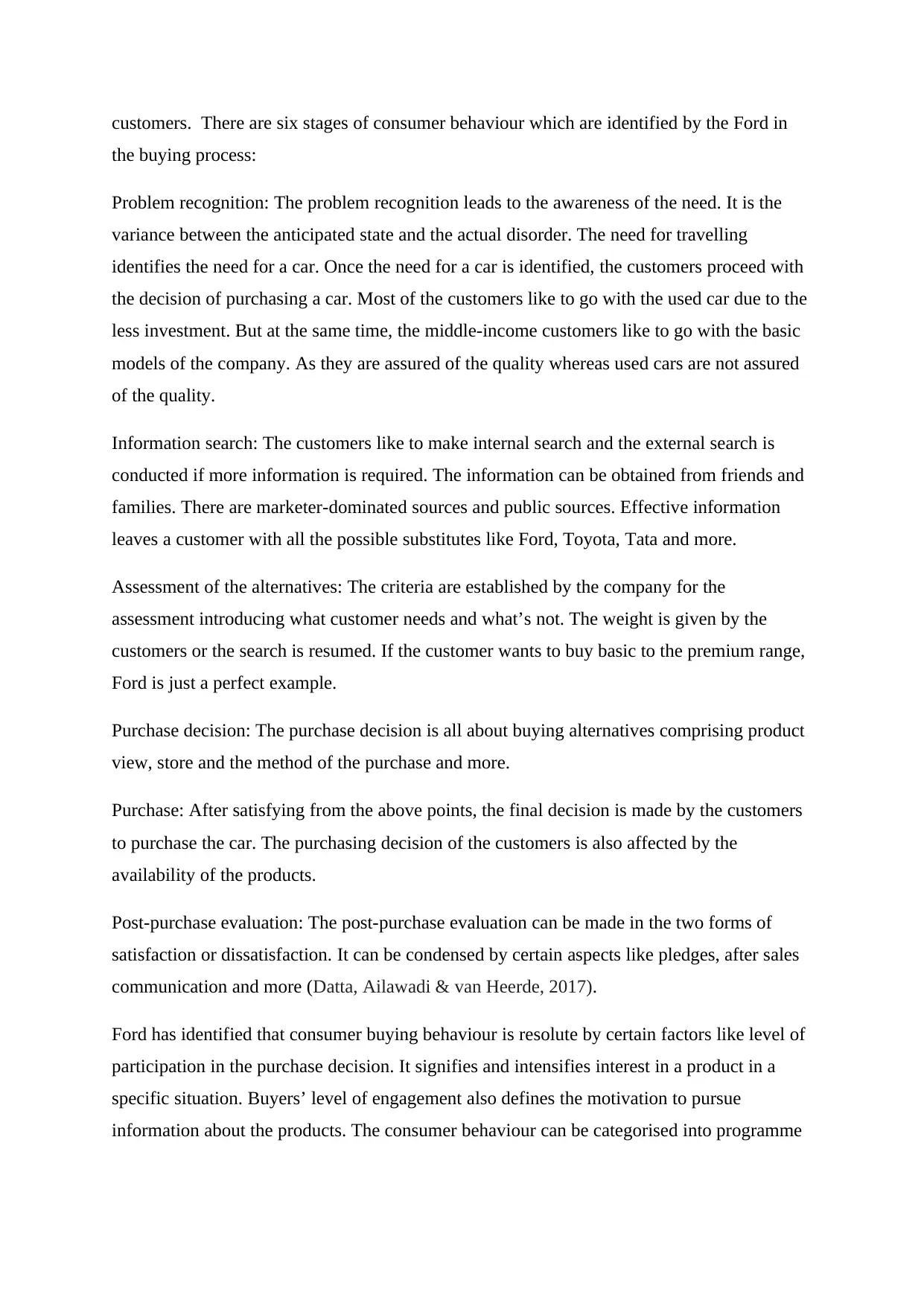
customers. There are six stages of consumer behaviour which are identified by the Ford in
the buying process:
Problem recognition: The problem recognition leads to the awareness of the need. It is the
variance between the anticipated state and the actual disorder. The need for travelling
identifies the need for a car. Once the need for a car is identified, the customers proceed with
the decision of purchasing a car. Most of the customers like to go with the used car due to the
less investment. But at the same time, the middle-income customers like to go with the basic
models of the company. As they are assured of the quality whereas used cars are not assured
of the quality.
Information search: The customers like to make internal search and the external search is
conducted if more information is required. The information can be obtained from friends and
families. There are marketer-dominated sources and public sources. Effective information
leaves a customer with all the possible substitutes like Ford, Toyota, Tata and more.
Assessment of the alternatives: The criteria are established by the company for the
assessment introducing what customer needs and what’s not. The weight is given by the
customers or the search is resumed. If the customer wants to buy basic to the premium range,
Ford is just a perfect example.
Purchase decision: The purchase decision is all about buying alternatives comprising product
view, store and the method of the purchase and more.
Purchase: After satisfying from the above points, the final decision is made by the customers
to purchase the car. The purchasing decision of the customers is also affected by the
availability of the products.
Post-purchase evaluation: The post-purchase evaluation can be made in the two forms of
satisfaction or dissatisfaction. It can be condensed by certain aspects like pledges, after sales
communication and more (Datta, Ailawadi & van Heerde, 2017).
Ford has identified that consumer buying behaviour is resolute by certain factors like level of
participation in the purchase decision. It signifies and intensifies interest in a product in a
specific situation. Buyers’ level of engagement also defines the motivation to pursue
information about the products. The consumer behaviour can be categorised into programme
the buying process:
Problem recognition: The problem recognition leads to the awareness of the need. It is the
variance between the anticipated state and the actual disorder. The need for travelling
identifies the need for a car. Once the need for a car is identified, the customers proceed with
the decision of purchasing a car. Most of the customers like to go with the used car due to the
less investment. But at the same time, the middle-income customers like to go with the basic
models of the company. As they are assured of the quality whereas used cars are not assured
of the quality.
Information search: The customers like to make internal search and the external search is
conducted if more information is required. The information can be obtained from friends and
families. There are marketer-dominated sources and public sources. Effective information
leaves a customer with all the possible substitutes like Ford, Toyota, Tata and more.
Assessment of the alternatives: The criteria are established by the company for the
assessment introducing what customer needs and what’s not. The weight is given by the
customers or the search is resumed. If the customer wants to buy basic to the premium range,
Ford is just a perfect example.
Purchase decision: The purchase decision is all about buying alternatives comprising product
view, store and the method of the purchase and more.
Purchase: After satisfying from the above points, the final decision is made by the customers
to purchase the car. The purchasing decision of the customers is also affected by the
availability of the products.
Post-purchase evaluation: The post-purchase evaluation can be made in the two forms of
satisfaction or dissatisfaction. It can be condensed by certain aspects like pledges, after sales
communication and more (Datta, Ailawadi & van Heerde, 2017).
Ford has identified that consumer buying behaviour is resolute by certain factors like level of
participation in the purchase decision. It signifies and intensifies interest in a product in a
specific situation. Buyers’ level of engagement also defines the motivation to pursue
information about the products. The consumer behaviour can be categorised into programme
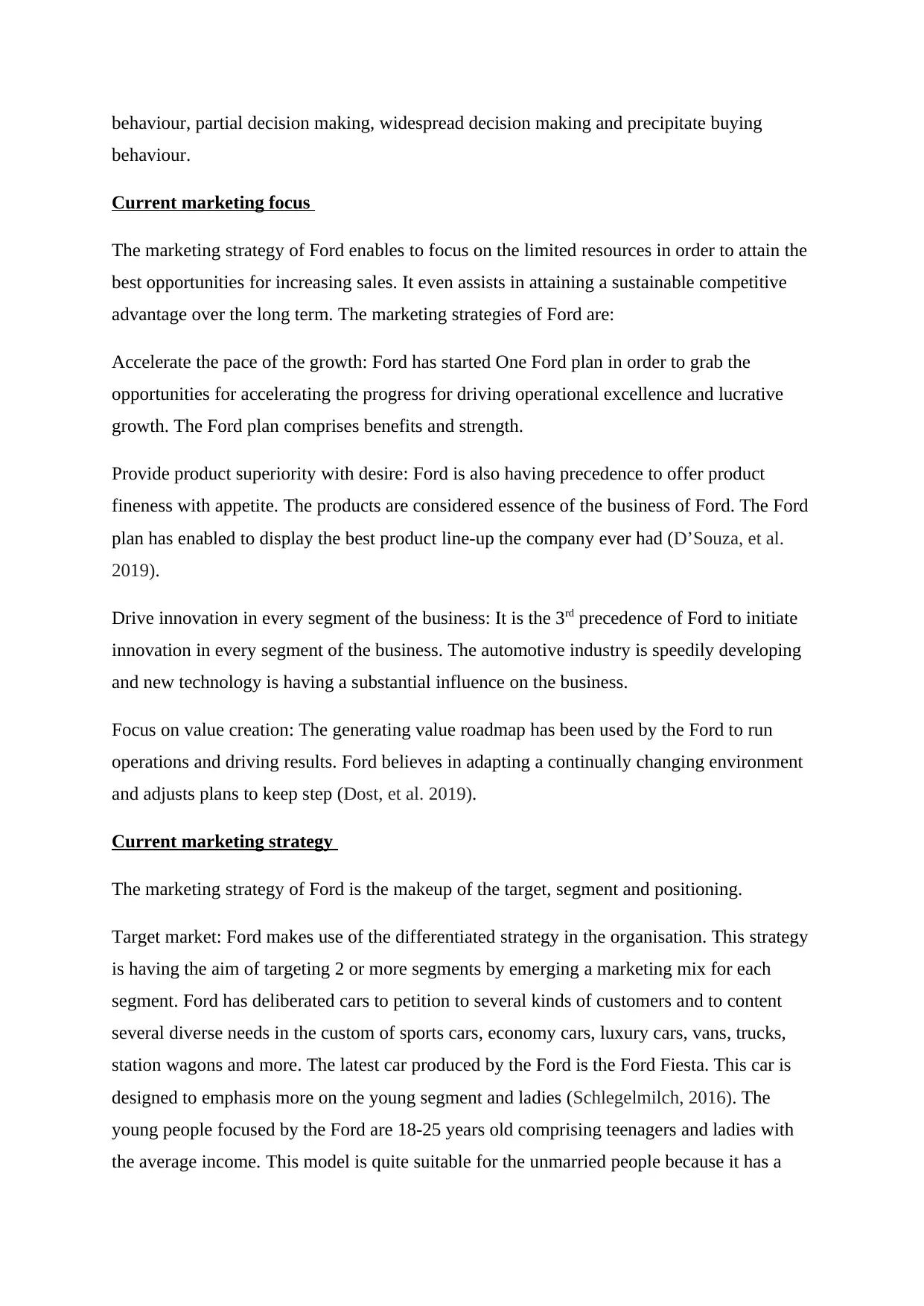
behaviour, partial decision making, widespread decision making and precipitate buying
behaviour.
Current marketing focus
The marketing strategy of Ford enables to focus on the limited resources in order to attain the
best opportunities for increasing sales. It even assists in attaining a sustainable competitive
advantage over the long term. The marketing strategies of Ford are:
Accelerate the pace of the growth: Ford has started One Ford plan in order to grab the
opportunities for accelerating the progress for driving operational excellence and lucrative
growth. The Ford plan comprises benefits and strength.
Provide product superiority with desire: Ford is also having precedence to offer product
fineness with appetite. The products are considered essence of the business of Ford. The Ford
plan has enabled to display the best product line-up the company ever had (D’Souza, et al.
2019).
Drive innovation in every segment of the business: It is the 3rd precedence of Ford to initiate
innovation in every segment of the business. The automotive industry is speedily developing
and new technology is having a substantial influence on the business.
Focus on value creation: The generating value roadmap has been used by the Ford to run
operations and driving results. Ford believes in adapting a continually changing environment
and adjusts plans to keep step (Dost, et al. 2019).
Current marketing strategy
The marketing strategy of Ford is the makeup of the target, segment and positioning.
Target market: Ford makes use of the differentiated strategy in the organisation. This strategy
is having the aim of targeting 2 or more segments by emerging a marketing mix for each
segment. Ford has deliberated cars to petition to several kinds of customers and to content
several diverse needs in the custom of sports cars, economy cars, luxury cars, vans, trucks,
station wagons and more. The latest car produced by the Ford is the Ford Fiesta. This car is
designed to emphasis more on the young segment and ladies (Schlegelmilch, 2016). The
young people focused by the Ford are 18-25 years old comprising teenagers and ladies with
the average income. This model is quite suitable for the unmarried people because it has a
behaviour.
Current marketing focus
The marketing strategy of Ford enables to focus on the limited resources in order to attain the
best opportunities for increasing sales. It even assists in attaining a sustainable competitive
advantage over the long term. The marketing strategies of Ford are:
Accelerate the pace of the growth: Ford has started One Ford plan in order to grab the
opportunities for accelerating the progress for driving operational excellence and lucrative
growth. The Ford plan comprises benefits and strength.
Provide product superiority with desire: Ford is also having precedence to offer product
fineness with appetite. The products are considered essence of the business of Ford. The Ford
plan has enabled to display the best product line-up the company ever had (D’Souza, et al.
2019).
Drive innovation in every segment of the business: It is the 3rd precedence of Ford to initiate
innovation in every segment of the business. The automotive industry is speedily developing
and new technology is having a substantial influence on the business.
Focus on value creation: The generating value roadmap has been used by the Ford to run
operations and driving results. Ford believes in adapting a continually changing environment
and adjusts plans to keep step (Dost, et al. 2019).
Current marketing strategy
The marketing strategy of Ford is the makeup of the target, segment and positioning.
Target market: Ford makes use of the differentiated strategy in the organisation. This strategy
is having the aim of targeting 2 or more segments by emerging a marketing mix for each
segment. Ford has deliberated cars to petition to several kinds of customers and to content
several diverse needs in the custom of sports cars, economy cars, luxury cars, vans, trucks,
station wagons and more. The latest car produced by the Ford is the Ford Fiesta. This car is
designed to emphasis more on the young segment and ladies (Schlegelmilch, 2016). The
young people focused by the Ford are 18-25 years old comprising teenagers and ladies with
the average income. This model is quite suitable for the unmarried people because it has a
⊘ This is a preview!⊘
Do you want full access?
Subscribe today to unlock all pages.

Trusted by 1+ million students worldwide
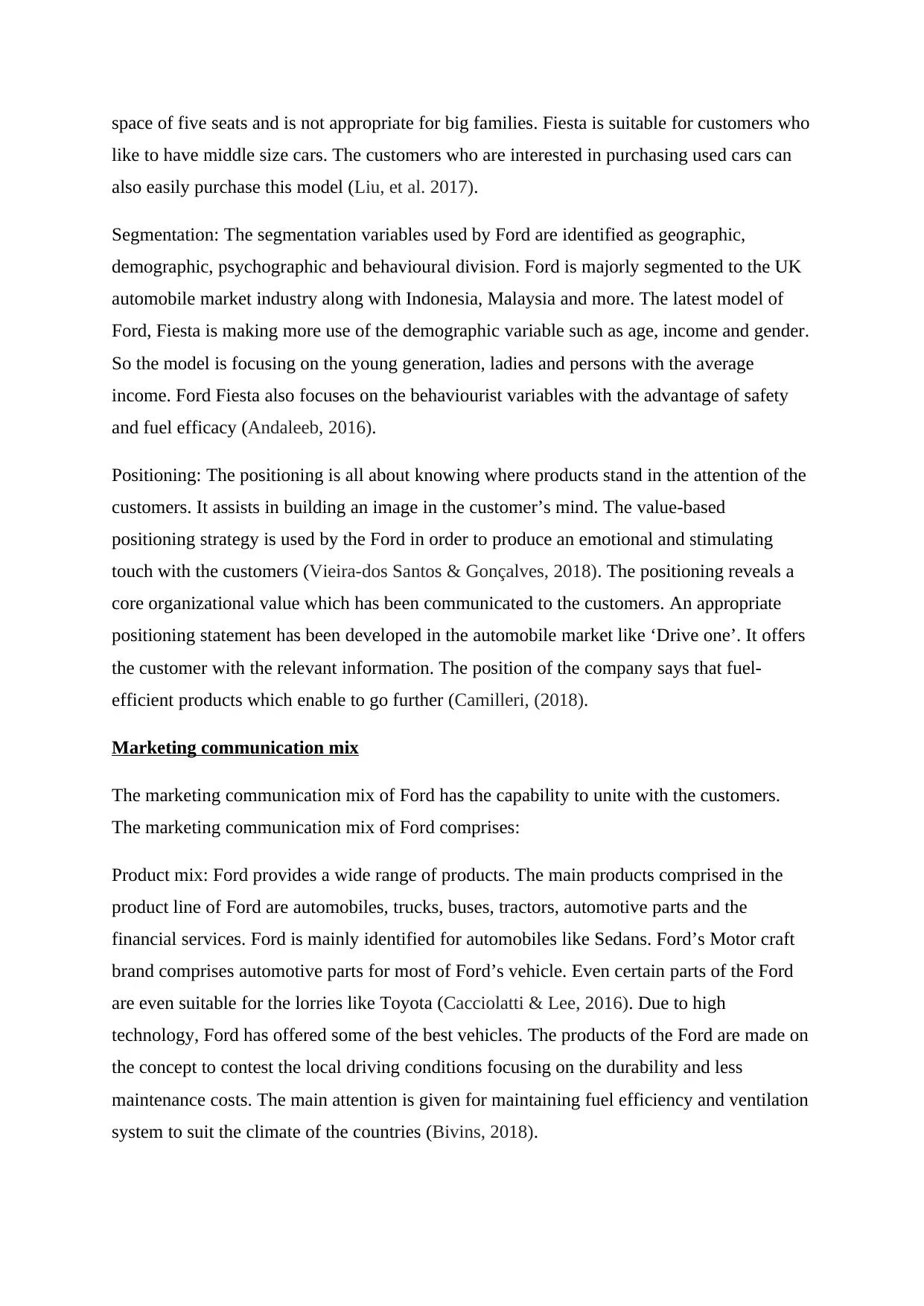
space of five seats and is not appropriate for big families. Fiesta is suitable for customers who
like to have middle size cars. The customers who are interested in purchasing used cars can
also easily purchase this model (Liu, et al. 2017).
Segmentation: The segmentation variables used by Ford are identified as geographic,
demographic, psychographic and behavioural division. Ford is majorly segmented to the UK
automobile market industry along with Indonesia, Malaysia and more. The latest model of
Ford, Fiesta is making more use of the demographic variable such as age, income and gender.
So the model is focusing on the young generation, ladies and persons with the average
income. Ford Fiesta also focuses on the behaviourist variables with the advantage of safety
and fuel efficacy (Andaleeb, 2016).
Positioning: The positioning is all about knowing where products stand in the attention of the
customers. It assists in building an image in the customer’s mind. The value-based
positioning strategy is used by the Ford in order to produce an emotional and stimulating
touch with the customers (Vieira-dos Santos & Gonçalves, 2018). The positioning reveals a
core organizational value which has been communicated to the customers. An appropriate
positioning statement has been developed in the automobile market like ‘Drive one’. It offers
the customer with the relevant information. The position of the company says that fuel-
efficient products which enable to go further (Camilleri, (2018).
Marketing communication mix
The marketing communication mix of Ford has the capability to unite with the customers.
The marketing communication mix of Ford comprises:
Product mix: Ford provides a wide range of products. The main products comprised in the
product line of Ford are automobiles, trucks, buses, tractors, automotive parts and the
financial services. Ford is mainly identified for automobiles like Sedans. Ford’s Motor craft
brand comprises automotive parts for most of Ford’s vehicle. Even certain parts of the Ford
are even suitable for the lorries like Toyota (Cacciolatti & Lee, 2016). Due to high
technology, Ford has offered some of the best vehicles. The products of the Ford are made on
the concept to contest the local driving conditions focusing on the durability and less
maintenance costs. The main attention is given for maintaining fuel efficiency and ventilation
system to suit the climate of the countries (Bivins, 2018).
like to have middle size cars. The customers who are interested in purchasing used cars can
also easily purchase this model (Liu, et al. 2017).
Segmentation: The segmentation variables used by Ford are identified as geographic,
demographic, psychographic and behavioural division. Ford is majorly segmented to the UK
automobile market industry along with Indonesia, Malaysia and more. The latest model of
Ford, Fiesta is making more use of the demographic variable such as age, income and gender.
So the model is focusing on the young generation, ladies and persons with the average
income. Ford Fiesta also focuses on the behaviourist variables with the advantage of safety
and fuel efficacy (Andaleeb, 2016).
Positioning: The positioning is all about knowing where products stand in the attention of the
customers. It assists in building an image in the customer’s mind. The value-based
positioning strategy is used by the Ford in order to produce an emotional and stimulating
touch with the customers (Vieira-dos Santos & Gonçalves, 2018). The positioning reveals a
core organizational value which has been communicated to the customers. An appropriate
positioning statement has been developed in the automobile market like ‘Drive one’. It offers
the customer with the relevant information. The position of the company says that fuel-
efficient products which enable to go further (Camilleri, (2018).
Marketing communication mix
The marketing communication mix of Ford has the capability to unite with the customers.
The marketing communication mix of Ford comprises:
Product mix: Ford provides a wide range of products. The main products comprised in the
product line of Ford are automobiles, trucks, buses, tractors, automotive parts and the
financial services. Ford is mainly identified for automobiles like Sedans. Ford’s Motor craft
brand comprises automotive parts for most of Ford’s vehicle. Even certain parts of the Ford
are even suitable for the lorries like Toyota (Cacciolatti & Lee, 2016). Due to high
technology, Ford has offered some of the best vehicles. The products of the Ford are made on
the concept to contest the local driving conditions focusing on the durability and less
maintenance costs. The main attention is given for maintaining fuel efficiency and ventilation
system to suit the climate of the countries (Bivins, 2018).
Paraphrase This Document
Need a fresh take? Get an instant paraphrase of this document with our AI Paraphraser
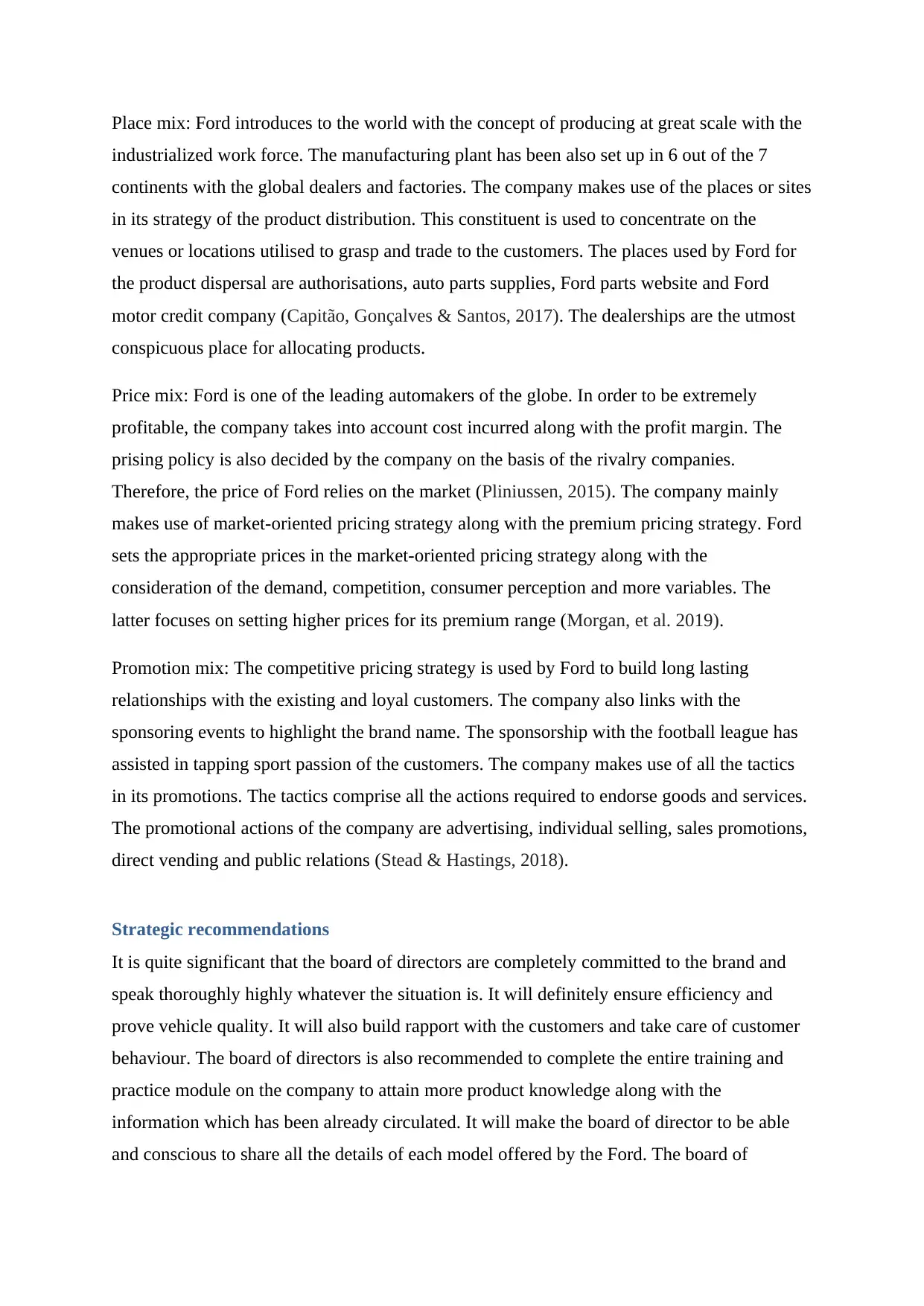
Place mix: Ford introduces to the world with the concept of producing at great scale with the
industrialized work force. The manufacturing plant has been also set up in 6 out of the 7
continents with the global dealers and factories. The company makes use of the places or sites
in its strategy of the product distribution. This constituent is used to concentrate on the
venues or locations utilised to grasp and trade to the customers. The places used by Ford for
the product dispersal are authorisations, auto parts supplies, Ford parts website and Ford
motor credit company (Capitão, Gonçalves & Santos, 2017). The dealerships are the utmost
conspicuous place for allocating products.
Price mix: Ford is one of the leading automakers of the globe. In order to be extremely
profitable, the company takes into account cost incurred along with the profit margin. The
prising policy is also decided by the company on the basis of the rivalry companies.
Therefore, the price of Ford relies on the market (Pliniussen, 2015). The company mainly
makes use of market-oriented pricing strategy along with the premium pricing strategy. Ford
sets the appropriate prices in the market-oriented pricing strategy along with the
consideration of the demand, competition, consumer perception and more variables. The
latter focuses on setting higher prices for its premium range (Morgan, et al. 2019).
Promotion mix: The competitive pricing strategy is used by Ford to build long lasting
relationships with the existing and loyal customers. The company also links with the
sponsoring events to highlight the brand name. The sponsorship with the football league has
assisted in tapping sport passion of the customers. The company makes use of all the tactics
in its promotions. The tactics comprise all the actions required to endorse goods and services.
The promotional actions of the company are advertising, individual selling, sales promotions,
direct vending and public relations (Stead & Hastings, 2018).
Strategic recommendations
It is quite significant that the board of directors are completely committed to the brand and
speak thoroughly highly whatever the situation is. It will definitely ensure efficiency and
prove vehicle quality. It will also build rapport with the customers and take care of customer
behaviour. The board of directors is also recommended to complete the entire training and
practice module on the company to attain more product knowledge along with the
information which has been already circulated. It will make the board of director to be able
and conscious to share all the details of each model offered by the Ford. The board of
industrialized work force. The manufacturing plant has been also set up in 6 out of the 7
continents with the global dealers and factories. The company makes use of the places or sites
in its strategy of the product distribution. This constituent is used to concentrate on the
venues or locations utilised to grasp and trade to the customers. The places used by Ford for
the product dispersal are authorisations, auto parts supplies, Ford parts website and Ford
motor credit company (Capitão, Gonçalves & Santos, 2017). The dealerships are the utmost
conspicuous place for allocating products.
Price mix: Ford is one of the leading automakers of the globe. In order to be extremely
profitable, the company takes into account cost incurred along with the profit margin. The
prising policy is also decided by the company on the basis of the rivalry companies.
Therefore, the price of Ford relies on the market (Pliniussen, 2015). The company mainly
makes use of market-oriented pricing strategy along with the premium pricing strategy. Ford
sets the appropriate prices in the market-oriented pricing strategy along with the
consideration of the demand, competition, consumer perception and more variables. The
latter focuses on setting higher prices for its premium range (Morgan, et al. 2019).
Promotion mix: The competitive pricing strategy is used by Ford to build long lasting
relationships with the existing and loyal customers. The company also links with the
sponsoring events to highlight the brand name. The sponsorship with the football league has
assisted in tapping sport passion of the customers. The company makes use of all the tactics
in its promotions. The tactics comprise all the actions required to endorse goods and services.
The promotional actions of the company are advertising, individual selling, sales promotions,
direct vending and public relations (Stead & Hastings, 2018).
Strategic recommendations
It is quite significant that the board of directors are completely committed to the brand and
speak thoroughly highly whatever the situation is. It will definitely ensure efficiency and
prove vehicle quality. It will also build rapport with the customers and take care of customer
behaviour. The board of directors is also recommended to complete the entire training and
practice module on the company to attain more product knowledge along with the
information which has been already circulated. It will make the board of director to be able
and conscious to share all the details of each model offered by the Ford. The board of
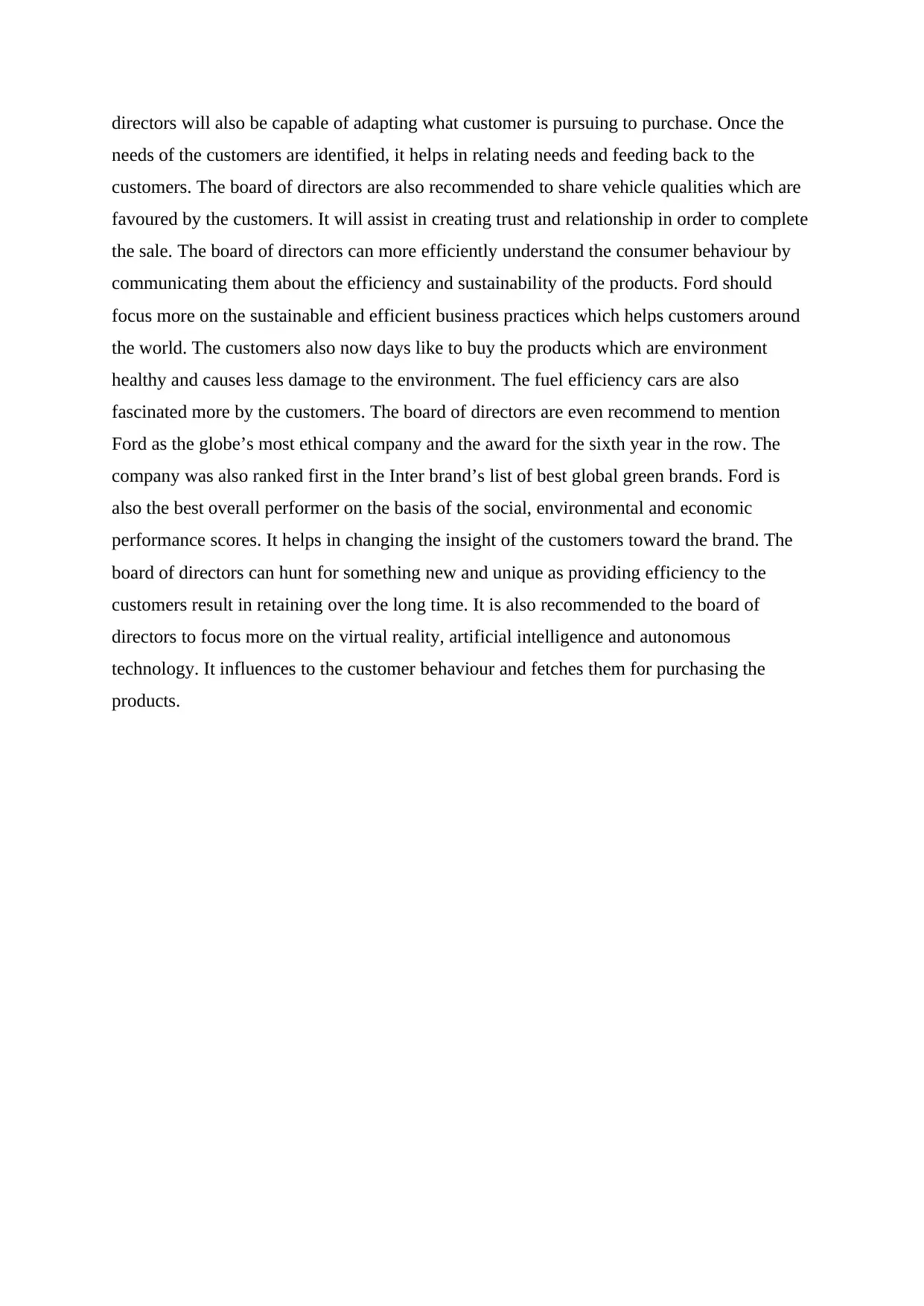
directors will also be capable of adapting what customer is pursuing to purchase. Once the
needs of the customers are identified, it helps in relating needs and feeding back to the
customers. The board of directors are also recommended to share vehicle qualities which are
favoured by the customers. It will assist in creating trust and relationship in order to complete
the sale. The board of directors can more efficiently understand the consumer behaviour by
communicating them about the efficiency and sustainability of the products. Ford should
focus more on the sustainable and efficient business practices which helps customers around
the world. The customers also now days like to buy the products which are environment
healthy and causes less damage to the environment. The fuel efficiency cars are also
fascinated more by the customers. The board of directors are even recommend to mention
Ford as the globe’s most ethical company and the award for the sixth year in the row. The
company was also ranked first in the Inter brand’s list of best global green brands. Ford is
also the best overall performer on the basis of the social, environmental and economic
performance scores. It helps in changing the insight of the customers toward the brand. The
board of directors can hunt for something new and unique as providing efficiency to the
customers result in retaining over the long time. It is also recommended to the board of
directors to focus more on the virtual reality, artificial intelligence and autonomous
technology. It influences to the customer behaviour and fetches them for purchasing the
products.
needs of the customers are identified, it helps in relating needs and feeding back to the
customers. The board of directors are also recommended to share vehicle qualities which are
favoured by the customers. It will assist in creating trust and relationship in order to complete
the sale. The board of directors can more efficiently understand the consumer behaviour by
communicating them about the efficiency and sustainability of the products. Ford should
focus more on the sustainable and efficient business practices which helps customers around
the world. The customers also now days like to buy the products which are environment
healthy and causes less damage to the environment. The fuel efficiency cars are also
fascinated more by the customers. The board of directors are even recommend to mention
Ford as the globe’s most ethical company and the award for the sixth year in the row. The
company was also ranked first in the Inter brand’s list of best global green brands. Ford is
also the best overall performer on the basis of the social, environmental and economic
performance scores. It helps in changing the insight of the customers toward the brand. The
board of directors can hunt for something new and unique as providing efficiency to the
customers result in retaining over the long time. It is also recommended to the board of
directors to focus more on the virtual reality, artificial intelligence and autonomous
technology. It influences to the customer behaviour and fetches them for purchasing the
products.
⊘ This is a preview!⊘
Do you want full access?
Subscribe today to unlock all pages.

Trusted by 1+ million students worldwide
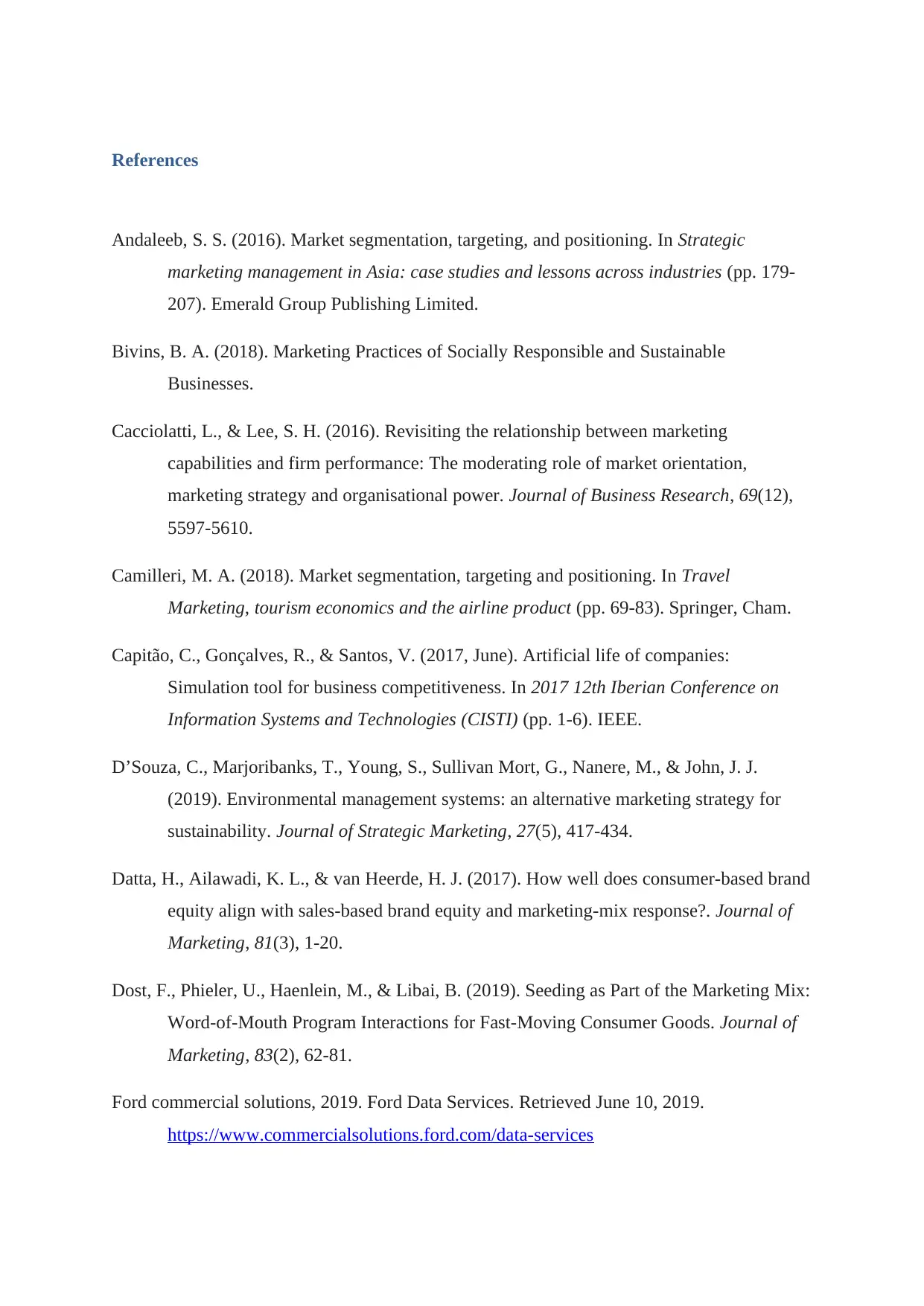
References
Andaleeb, S. S. (2016). Market segmentation, targeting, and positioning. In Strategic
marketing management in Asia: case studies and lessons across industries (pp. 179-
207). Emerald Group Publishing Limited.
Bivins, B. A. (2018). Marketing Practices of Socially Responsible and Sustainable
Businesses.
Cacciolatti, L., & Lee, S. H. (2016). Revisiting the relationship between marketing
capabilities and firm performance: The moderating role of market orientation,
marketing strategy and organisational power. Journal of Business Research, 69(12),
5597-5610.
Camilleri, M. A. (2018). Market segmentation, targeting and positioning. In Travel
Marketing, tourism economics and the airline product (pp. 69-83). Springer, Cham.
Capitão, C., Gonçalves, R., & Santos, V. (2017, June). Artificial life of companies:
Simulation tool for business competitiveness. In 2017 12th Iberian Conference on
Information Systems and Technologies (CISTI) (pp. 1-6). IEEE.
D’Souza, C., Marjoribanks, T., Young, S., Sullivan Mort, G., Nanere, M., & John, J. J.
(2019). Environmental management systems: an alternative marketing strategy for
sustainability. Journal of Strategic Marketing, 27(5), 417-434.
Datta, H., Ailawadi, K. L., & van Heerde, H. J. (2017). How well does consumer-based brand
equity align with sales-based brand equity and marketing-mix response?. Journal of
Marketing, 81(3), 1-20.
Dost, F., Phieler, U., Haenlein, M., & Libai, B. (2019). Seeding as Part of the Marketing Mix:
Word-of-Mouth Program Interactions for Fast-Moving Consumer Goods. Journal of
Marketing, 83(2), 62-81.
Ford commercial solutions, 2019. Ford Data Services. Retrieved June 10, 2019.
https://www.commercialsolutions.ford.com/data-services
Andaleeb, S. S. (2016). Market segmentation, targeting, and positioning. In Strategic
marketing management in Asia: case studies and lessons across industries (pp. 179-
207). Emerald Group Publishing Limited.
Bivins, B. A. (2018). Marketing Practices of Socially Responsible and Sustainable
Businesses.
Cacciolatti, L., & Lee, S. H. (2016). Revisiting the relationship between marketing
capabilities and firm performance: The moderating role of market orientation,
marketing strategy and organisational power. Journal of Business Research, 69(12),
5597-5610.
Camilleri, M. A. (2018). Market segmentation, targeting and positioning. In Travel
Marketing, tourism economics and the airline product (pp. 69-83). Springer, Cham.
Capitão, C., Gonçalves, R., & Santos, V. (2017, June). Artificial life of companies:
Simulation tool for business competitiveness. In 2017 12th Iberian Conference on
Information Systems and Technologies (CISTI) (pp. 1-6). IEEE.
D’Souza, C., Marjoribanks, T., Young, S., Sullivan Mort, G., Nanere, M., & John, J. J.
(2019). Environmental management systems: an alternative marketing strategy for
sustainability. Journal of Strategic Marketing, 27(5), 417-434.
Datta, H., Ailawadi, K. L., & van Heerde, H. J. (2017). How well does consumer-based brand
equity align with sales-based brand equity and marketing-mix response?. Journal of
Marketing, 81(3), 1-20.
Dost, F., Phieler, U., Haenlein, M., & Libai, B. (2019). Seeding as Part of the Marketing Mix:
Word-of-Mouth Program Interactions for Fast-Moving Consumer Goods. Journal of
Marketing, 83(2), 62-81.
Ford commercial solutions, 2019. Ford Data Services. Retrieved June 10, 2019.
https://www.commercialsolutions.ford.com/data-services
Paraphrase This Document
Need a fresh take? Get an instant paraphrase of this document with our AI Paraphraser
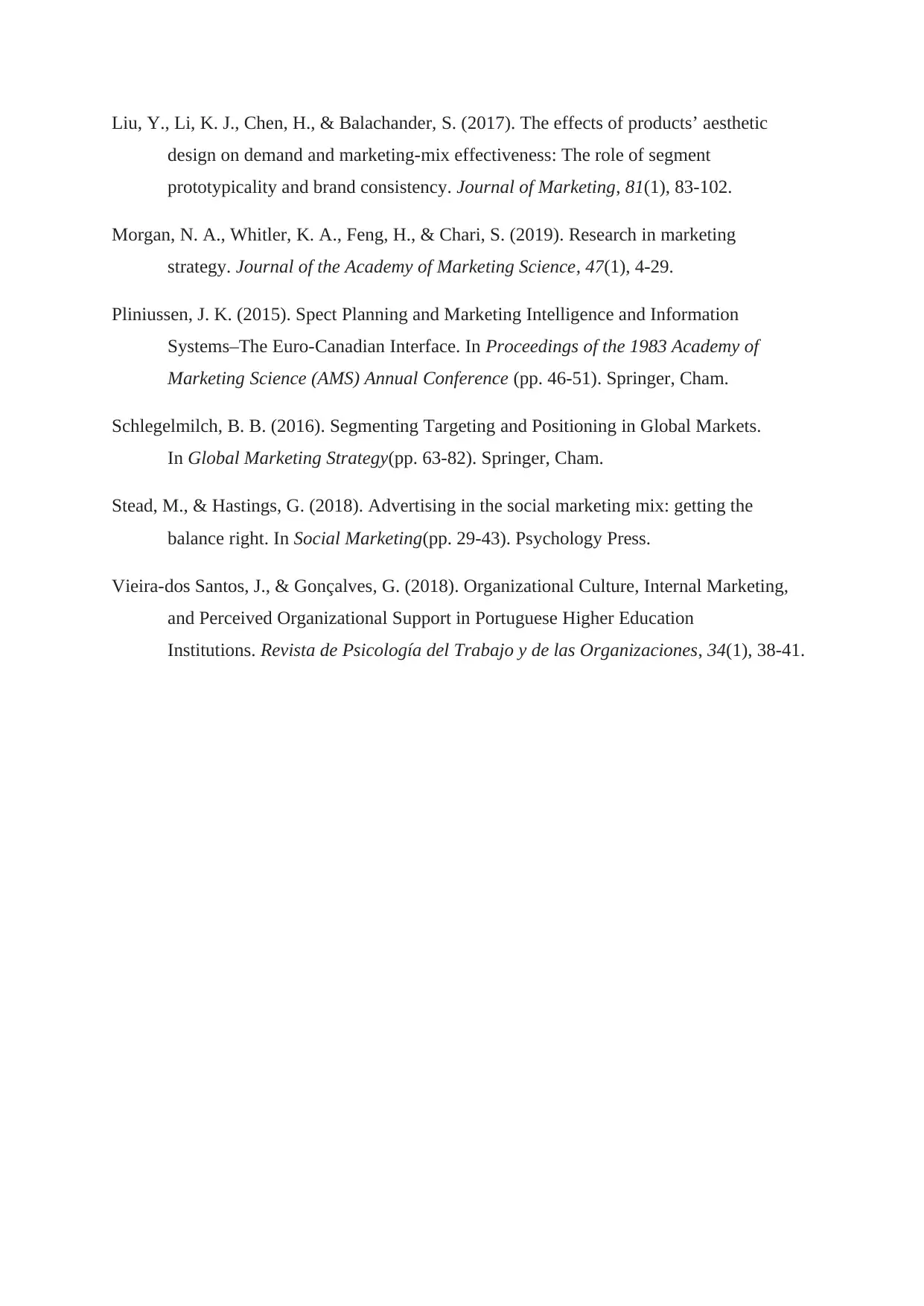
Liu, Y., Li, K. J., Chen, H., & Balachander, S. (2017). The effects of products’ aesthetic
design on demand and marketing-mix effectiveness: The role of segment
prototypicality and brand consistency. Journal of Marketing, 81(1), 83-102.
Morgan, N. A., Whitler, K. A., Feng, H., & Chari, S. (2019). Research in marketing
strategy. Journal of the Academy of Marketing Science, 47(1), 4-29.
Pliniussen, J. K. (2015). Spect Planning and Marketing Intelligence and Information
Systems–The Euro-Canadian Interface. In Proceedings of the 1983 Academy of
Marketing Science (AMS) Annual Conference (pp. 46-51). Springer, Cham.
Schlegelmilch, B. B. (2016). Segmenting Targeting and Positioning in Global Markets.
In Global Marketing Strategy(pp. 63-82). Springer, Cham.
Stead, M., & Hastings, G. (2018). Advertising in the social marketing mix: getting the
balance right. In Social Marketing(pp. 29-43). Psychology Press.
Vieira-dos Santos, J., & Gonçalves, G. (2018). Organizational Culture, Internal Marketing,
and Perceived Organizational Support in Portuguese Higher Education
Institutions. Revista de Psicología del Trabajo y de las Organizaciones, 34(1), 38-41.
design on demand and marketing-mix effectiveness: The role of segment
prototypicality and brand consistency. Journal of Marketing, 81(1), 83-102.
Morgan, N. A., Whitler, K. A., Feng, H., & Chari, S. (2019). Research in marketing
strategy. Journal of the Academy of Marketing Science, 47(1), 4-29.
Pliniussen, J. K. (2015). Spect Planning and Marketing Intelligence and Information
Systems–The Euro-Canadian Interface. In Proceedings of the 1983 Academy of
Marketing Science (AMS) Annual Conference (pp. 46-51). Springer, Cham.
Schlegelmilch, B. B. (2016). Segmenting Targeting and Positioning in Global Markets.
In Global Marketing Strategy(pp. 63-82). Springer, Cham.
Stead, M., & Hastings, G. (2018). Advertising in the social marketing mix: getting the
balance right. In Social Marketing(pp. 29-43). Psychology Press.
Vieira-dos Santos, J., & Gonçalves, G. (2018). Organizational Culture, Internal Marketing,
and Perceived Organizational Support in Portuguese Higher Education
Institutions. Revista de Psicología del Trabajo y de las Organizaciones, 34(1), 38-41.
1 out of 11
Related Documents
Your All-in-One AI-Powered Toolkit for Academic Success.
+13062052269
info@desklib.com
Available 24*7 on WhatsApp / Email
![[object Object]](/_next/static/media/star-bottom.7253800d.svg)
Unlock your academic potential
Copyright © 2020–2026 A2Z Services. All Rights Reserved. Developed and managed by ZUCOL.





